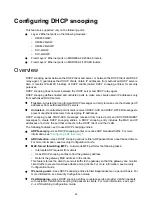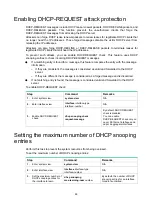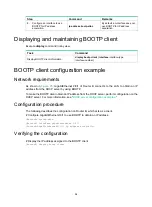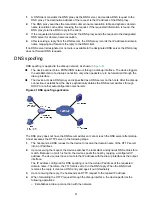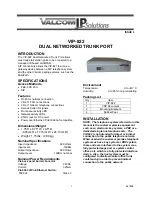
95
Configuring DNS
Overview
Domain Name System (DNS) is a distributed database used by TCP/IP applications to translate
domain names into IP addresses. The domain name-to-IP address mapping is called a DNS entry.
DNS services can be static or dynamic. After a user specifies a name, the device checks the static
name resolution table for an IP address. If no IP address is available, it contacts the DNS server for
dynamic name resolution, which takes more time than static name resolution. To improve efficiency,
you can add DNS entries for domain names whose IP addresses are fixed to the local static name
resolution table.
Static domain name resolution
Static domain name resolution means manually creating mappings between domain names and IP
addresses. For example, you can create a static DNS mapping for a device so that you can Telnet to
the device by using the domain name.
Dynamic domain name resolution
Resolution process
1.
A user program sends a name query to the resolver of the DNS client.
2.
The DNS resolver looks up the local domain name cache for a match. If the resolver finds a
match, it sends the corresponding IP address back. If not, it sends a query to the DNS server.
3.
The DNS server looks up the corresponding IP address of the domain name in its DNS
database. If no match is found, the server sends a query to other DNS servers. This process
continues until a result, whether successful or not, is returned.
4.
After receiving a response from the DNS server, the DNS client returns the resolution result to
the user program.
shows the relationship between the user program, DNS client, and DNS server.
The DNS client includes the resolver and cache. The user program and DNS client can run on the
same device or different devices. The DNS server and the DNS client usually run on different
devices.
Figure 39 Dynamic domain name resolution
Request
Response
Response
Request
Save
Read
DNS client
DNS server
Resolver
Cache
User
program



